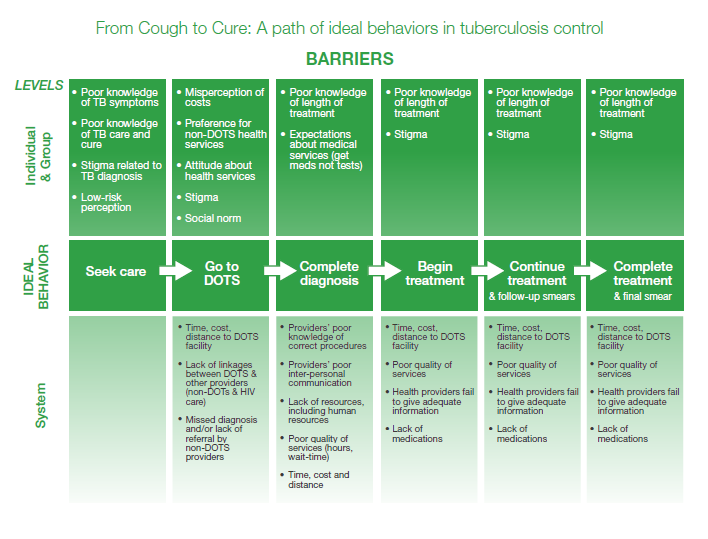Content Status
Type
Linked Node
ACSM planning based on needs assessment
Learning ObjectivesACSM planning based on needs assessment
The preparation of a research and evidence-based Programme Implementation Plan (PIP) is vital for conducting effective Advocacy, Communication and Social Mobilisation (ACSM) activities under the National TB Elimination Programme (NTEP). The plan for ACSM activities should be made based on the needs of the community.
Needs Assessment through Situation Analysis
Situation analysis should start at the TB Unit (TU) level. The Senior Treatment Supervisor (STS) should take the initiative under the guidance and supervision of the District TB Officer (DTO).
STEP 1: Identify the priority population/ geographic area
- Prepare a performance matrix for all TUs and Designated Microscopy Centres (DMCs) in the district on the basis of presumptive TB examination rate, case detection, case adherence, treatment success rate and private notification.
Table 1: Example of performance matrix (district X in state Y)
| Tuberculosis Unit (TU) | Presumptive TB Examination Rate % |
Case notification % |
Case adherence % |
Treatment Success Rate % |
Private notification % |
| TU 1 | |||||
| TU 2 | |||||
| TU 3 | |||||
| TU 4 |
- Identify the TUs/DMCs with lower performance indicators and prioritize them for ACSM activities with targeted solutions to existing challenges. Work out the likely budget and time constraints for ACSM intervention in the current financial year and in the next two years or so, in these.
- Sustain ACSM activities in other DMCs
STEP 2: Identifying key program challenges
Ascertain the main program issues in the low-performing DMCs that have been identified as priority areas by asking the following guiding questions to Medical Officer - Tuberculosis Control (MO-TC), Senior TB Laboratory Supervisor (STLS), and other concerned health staff like Accredited Social Health Activist (ASHA).
a. What are the reasons for low case detections?
i. Lack of awareness about TB
ii. High stigma and discrimination
iii. Poor access to services
b. What are the reasons for low case adherence?
i. Economic hardship
ii. Lack of care and support
iii. Lack of awareness about the importance of completing treatment
c. What are the reasons for low private notification?
i. Lack of information about the need for TB notification
ii. Lack of knowledge about TB, its diagnosis, and treatment
iii. Lack of motivation and fear of patient loss
Responses to these questions will help in identifying the various program challenges and in planning appropriate ACSM activities.
Step 3: Identify the barriers for utilisation of services
The Cough to Cure Pathway barrier analysis is a useful tool to discuss key barriers at every level in the journey from symptom to treatment. This approach is suitable to differentiate the barriers at the individual, group, and system levels.

Figure: The Cough to Cure Pathway Barrier Analysis Tool; Source: Advocacy, Communication & Social Mobilisation (ACSM) for Tuberculosis Control - A Handbook for Country Programmes, WHO, 2007.
STEP 4: Identifying and defining the target audience
The target audience for advocacy . communication and social mobilisation activities need to be decided based on the requirement
Resources
- Advocacy, Communication & Social Mobilization (ACSM) for Tuberculosis Control - A Handbook for Country Programmes, WHO, 2007.
- Operational Handbook on Advocacy, Communication & Social Mobilisation for RNTCP, Central TB Division, MoHFW, GoI, 2014.
Assessment:
| Question | Answer 1 | Answer 2 | Answer 3 | Answer 4 | Correct answer | Correct explanation | Page id | Part of Pre-test | Part of Post-test |
| Cough to cure pathway tool helps in identifying: | The audience for ACSM activities | Barriers to ideal behaviours | Communication strategy | None of the above | 2 |
The Cough to Cure Pathway barrier analysis is a useful tool to discuss key barriers at every level in the journey from symptom to treatment. This approach is suitable to differentiate the barriers at the individual, group, and system levels.
|
| Yes | Yes |
Content Creator
Reviewer
Target Audience
- Log in to post comments